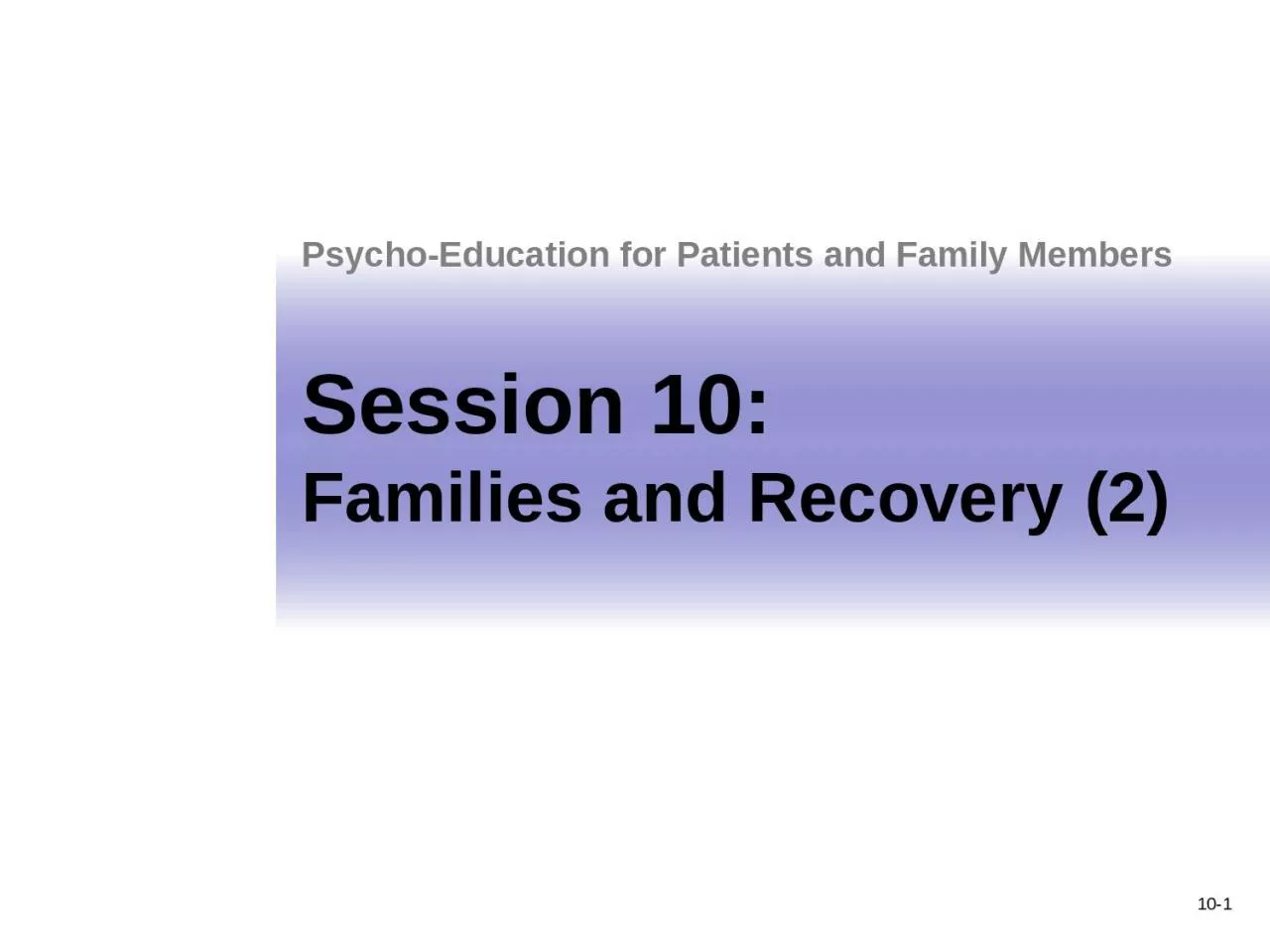

PsychoEducation for Patients and Family Members 10 1 10 2 Recovery Stages Stage 1 Withdrawal 12 weeks Stage 2 Early Abstinence or Honeymoon following 1 month Stage 3 Protracted Abstinence or the Wall ID: 1020981
Download Presentation The PPT/PDF document "Session 10: Families and Recovery (2)" is the property of its rightful owner. Permission is granted to download and print the materials on this web site for personal, non-commercial use only, and to display it on your personal computer provided you do not modify the materials and that you retain all copyright notices contained in the materials. By downloading content from our website, you accept the terms of this agreement.
1. Session 10:Families and Recovery (2)Psycho-Education for Patients and Family Members10-1
2. 10-2Recovery StagesStage 1: Withdrawal (1-2 weeks)Stage 2: Early Abstinence or “Honeymoon”(following 1 month) Stage 3: Protracted Abstinence or “the Wall”(following 3-4 months)Stage 4: Adjustment/Resolution(following 2 months)
3. Question:How is the Withdrawal stage (first 1-2 weeks from abstinence) characterized?1-3
4. WithdrawalLasts 1 to 2 weeksCraving and depressionLow energy, difficulty sleeping, increased appetite, and difficulty concentrating, excessive respiration, weight loss, fever, infection, hallucination, illusion, confusion10-4
5. Question:How is the Honeymoon stage (following 1 month) characterized?1-5
6. HoneymoonLasts about 1 month following the Withdrawal stageIncreased energy, enthusiasm, and optimismPeople often feel they are “cured” when they reach this stage10-6
7. Question:How is the Wall stage (following 3 to 4 months) characterized?1-7
8. The WallLasts about 3 to 4 months following the Honeymoon stageHardest stage of recoveryDepression and irritabilityDifficulty concentratingLow energy and loss of enthusiasmHigh risk of relapse10-8
9. Question:How is the Readjustment stage (following 2 or more months) characterized?1-9
10. ReadjustmentLast 2 months or longer following the Wall stageThe person in recovery and the family begin returning to more normal lifestyleAfter extended abstinence, the person in recovery and family members begin working on marital, emotional, and psychological issues that will strengthen the family10-10
11. Person in recoveryDiscontinue use of ShabuLearn specific techniques for avoiding relapseLearn about the process of addiction and about drug effectsFamily membersDecide to be part of recovery processRecognize that addiction is a medical conditionGoals for Withdrawal(mainly for those in outpatient treatment)10-11
12. Person in recoveryImprove physical healthIdentify personal triggers and relapse justificationsUse targeted techniques to stay abstinentFamily membersWork to support recoveryRecognize and discontinue triggering interactionsGoals for the Honeymoon(mainly for those in outpatient treatment)10-12
13. Goals for the Wall(mainly for those in outpatient treatment)Person in recoveryMaintain stable abstinence from all drugsRepair significant relationshipsDevelop a recovery support system outside the treatment centerRecognize and cope with dangerous emotionsFamily membersDecide whether to recommit to the relationshipBegin finding ways to enrich own livesPractice healthy communication skills10-13
14. Goals for ReadjustmentPerson in recoveryMonitor components of successful recoveryRecognize relapse indicators and prepare responsesClarify new roles in healthy relationshipsSet goals for continuing a new lifestyle after the programFamily membersAccept limitations of living with a person in recoveryDevelop an individual, healthy, balanced lifestyleMonitor self for relapses to former behaviorsBe patient with the process of recovery10-14
15. Key Relapse Issues for People in RecoveryFriends who use ShabuEnvironmental cues associated with Shabu useSevere cravingsProtracted abstinence—the Wall (for those in outpatient treatment)Connection between Shabu and sexBoredom10-15
16. Key Relapse Issues for Family MembersCommon problems preceding a slip back into old behaviors for family members are:Fear of the person in recovery returning to Shabu useFear of being aloneLack of individual goals and interestsInability to release responsibility for the person in recovery10-16